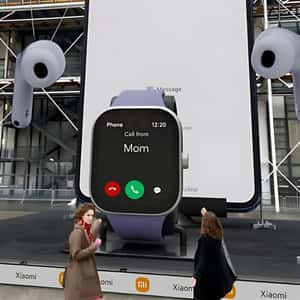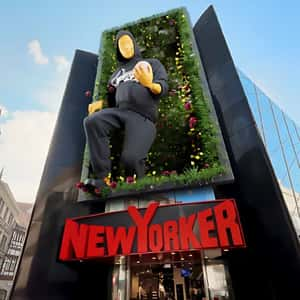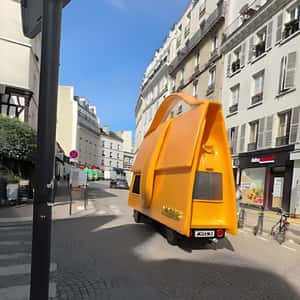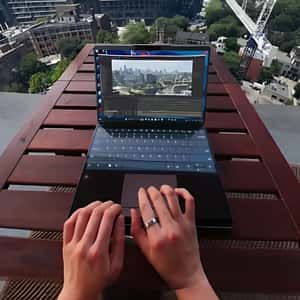4 Reasons Why FOOH Advertising is Essential for Brands in 2026
Discover the top FOOH advertising trends shaping 2026 and learn how to make your campaigns stand out in a crowded digital landscape.

Fake Out of Home advertising, or FOOH advertising, has reshaped the advertising industry. And in recent years, it’s setting the stage for what promises to be an even more innovative future in 2026.
This modern approach is one of the most successful marketing trends in elevating traditional advertising to the next level through hyper-realistic short-form content on social media.
In a world of endless ad scrolling and “ad fatigue,” FOOH offers a refreshing change. It grabs attention and actually makes people stop and engage. But what exactly are Fake Out of Home ads?
How do Fake Out of Home ads work?
Fake Out of Home (FOOH) advertising is short videos lasting 10 to 15 seconds. These clips combine real footage of famous landmarks or city views with stunning CGI animations.
These videos target platforms like TikTok, Instagram, YouTube Shorts, and Meta. Perfect for social media where short-form content is popular. These ads replicate the feel of grand billboards or massive public displays.
But they live entirely online, making them much more flexible and cost-effective.
If you want to know everything about FOOH advertising, here’s a guide to Fake Out of Home Ads.
In 2026, FOOH ads are reshaping how brands connect with people. Consider the numbers: 91% of people think ads have become overly intrusive. 87% believe there are more ads now than ever, and the average person encounters 4,000 to 10,000 ads daily.
It’s no surprise that 83% of people filter out ads that are repetitive and annoying. The modern consumer isn’t overwhelmed – they’re tuning out. [1]
That’s where Fake Out of Home enters the picture. Advancements in augmented reality (AR) and AI make FOOH advertising look incredibly realistic. And these campaigns are especially effective at catching attention.
FOOH stands out from typical ads. It surprises, entertains, and gets viewers to engage and share. For brands, these campaigns are a powerful way to cut through the noise.
They help you stay relevant and connect with your audience in a meaningful way.
4 Key Drivers of Fake Out of Home Advertising in 2026
Fake Out of Home advertising is revolutionizing how brands approach digital marketing. As we head into 2026, four key factors are making FOOH a crucial strategy for brands and agencies.
These drivers allow you to create memorable and impactful ad campaigns.
1. Virtual Integration with Reality
As AR and VR technologies continue to grow, investing in AR will be key for advertising by 2026. Look at AR examples like Snapchat’s AR glasses and Meta’s mixed-reality headsets. These tools prove the growing accessibility and appeal of AR-driven experiences.
And it won’t stop there.
FOOH campaigns may not be interactive like AR, but they share one goal. To create engaging and unforgettable experiences. Brands using AR now can learn to enhance storytelling and create illusions in their FOOH campaigns later.
The challenge with AR has always been figuring out how to show off those experiences in an out-of-home setting, but FOOH solves that. Hyperrealistic FOOH ads make AR experiences more exciting and accessible to a larger audience.
Plus, this combo isn’t just a passing trend.
With the global AR market expected to reach $8 billion by 2029, it’s clear that AR and FOOH will only keep amplifying each other.
For marketers, this means endless creative possibilities to stand out.
Want to read more about it? Check out our newest blog on How AR is redefining FOOH in 2026.
2. Increased Cost-efficiency and Flexibility
A main driver for Fake Out of Home (FOOH) advertising in 2026 is its ability to deliver high-impact campaigns. And without the hefty price tag of traditional ads.
Fake Out of Home saves money by eliminating the need to rent billboard space. It also removes the hassle of creating ads for different regions and languages.
Instead, a single, well-made video lasting 10 to 15 seconds can be shared online. This video can quickly go viral and organically reach a huge audience worldwide.
FOOH differs from traditional advertising. You don’t need to compete for top spots or prime times. It’s not limited to certain places or schedules. This flexibility allows marketers to roll out campaigns at the perfect moment and fine-tune their targeting strategies.
It’s all about getting the right message to the right audience, without the logistical headaches of physical ad placements.
3. High Potential for Organic Virality
FOOH advertising is practically built for social media. These quick, powerful campaigns aim to catch attention in a sea of endless content. Social media platforms such as TikTok, Instagram, and YouTube offer FOOH ads a great way to connect with millions.
And when people engage with these ads, it sets off a ripple effect.
The more people interact, the more likely platforms are to push them to even bigger audiences. This means you can leverage social media algorithms to extend your reach organically, without constantly pouring money into ad spend.
And for a world where attention spans are shrinking and ad fatigue is real, FOOH ads bring something fresh to the table. This kind of organic momentum amplifies a brand’s visibility and also builds stronger connections with audiences, who see the content as entertaining rather than intrusive.
4. Smarter and Data-driven Targeting
With fake out-of-home advertising, targeting the right audience has never been easier. Brands can use platforms like Instagram, Meta, and TikTok.
These sites have built-in analytic tools. This helps them create targeted campaigns. They can focus on specific interests, demographics, and behaviors.
For any brand or agency looking to maximize their reach and precision, FOOH offers a level of adaptability that’s hard to beat. This personalized approach doesn’t just boost engagement. It also ensures that ads resonate with the people who matter most to your brand.
In 2026, leveraging data to target smarter is a game-changer and can help you cut through the noise and make your campaigns truly impactful.
3 Examples of Successful Fake Out of Home Campaigns
A good Fake Out of Home (FOOH) ad doesn’t just blend in. It’s clever, creative, and uses hyperrealistic elements that seem to pop out of the screen, creating an experience that feels almost too real to be true. Here are three examples that nailed the FOOH formula and got people talking.
1. Mercedes “MANUFAKTUR” Garage in Tokyo
This ad from Mercedes is a prime example of how FOOH ads can take off and go viral. In this snappy ad, Mercedes showcases a cool, futuristic building in Tokyo that looks like a vertical parking garage. A man stands outside, watching the bright Mercedes-AMG SLs being shown inside the Manufaktur factory.
The ad highlights the brand’s top-tier paint job and custom interiors, inviting viewers to imagine their own personalized ride. With over 500k likes and 44 million views, this video proves FOOH ads can catch attention and go viral. It shows just how impactful these campaigns can be.
2. dm-drogerie markt’s “Trend It Up” collection
FOOH ads are changing how we use AR. And they go beyond just trying on makeup or seeing furniture. Take this video from dm-drogerie markt as an example.
In the ad, a girl strolls through a store. Suddenly, the floor in front of her “opens up.” It shows an underground area that looks like a pool, but it’s empty. Instead, human-sized matte lipstick bullets from the trend it up collection fill the space. Some are capped, while others are uncapped.
The girl hops from one capped lipstick to another, like she’s in a real-life video game.
After making it safely across and back to solid ground, she bursts out laughing, adding a fun, relatable touch. The ad ended up getting 300k likes, proving how FOOH ads can really level up how we interact with augmented reality.
3. Vivo’s “UEFA EURO” in 2024
This Vivo’s Soccer Ball ad is the perfect example of how fake out of home ads are highly cost efficient and flexible. Vivo skipped the high costs of posting ads at famous places. Instead, they used CGI animation to show the UEFA EURO 2024 soccer ball traveling the globe.
This ad is a creative way to make a worldwide impact without breaking the bank, proving how flexible and cost-effective FOOH ads can be.
The 3 Pillars of a Successful FOOH Advertising
A successful Fake Out of Home campaign focuses on building an experience that speaks to your audience. It should also align with your brand’s goals and messaging.
Here are the three essential ingredients, every standout FOOH campaign needs:
1. A Hook That Hooks You
In the fast-paced world of social media, the first few seconds of your FOOH ad are crucial. Your content needs to hook the audience instantly and leave them wanting more. Successful FOOH ads mirror the social media sentiment: they start at the climax, tease something exciting, and build anticipation.
How to Do It:
- Begin your video with the most visually striking or unexpected moment.
- Create a sense of intrigue that encourages viewers to stay and share.
- Design your FOOH ad to feel like it’s leading to something even bigger, keeping the audience engaged.
Always keep in mind: FOOH campaigns aren’t just about looking good – they’re about stopping the scroll and driving engagement. A strong hook ensures your ad gets noticed and remembered.
2. A Narrative That Aligns with Your Brand
FOOH Advertising is most impactful when it is an authentic extension of your brand’s story. They shouldn’t feel like a one-off attempt to hop on a trend. Instead, your FOOH asset should reinforce your brand’s identity. It should excite your audience with fresh, original ideas.
Take Pepsi’s campaign for its new logo as an example. To announce their new global logo, they went all out and made it a worldwide event. They didn’t just post a simple announcement; they made it a spectacle.
From a giant Pepsi can in London to an insane drone light show in Ain Dubai, and even a helicopter dropping a massive can in Lahore, every second of the FOOH ad screamed excitement. And these scenes weren’t just chosen randomly, it all tied back to their message: “The new Pepsi era is now.”
Pepsi used FOOH in their global story and Instagram marketing. They turned a simple logo reveal into a viral, unforgettable celebration.
Check out more great FOOH Ad examples in our library!**
3. The Right Team to Execute Your Vision
Behind every great FOOH campaign is a team that understands how to combine creativity with flawless technical execution. Picking the right partner ensures everything works well together.
This includes the hook, aligning the campaign with your brand’s story, and mixing real-world video with CGI/VFX.
How to choose the right partner:
- Look for teams with a proven track record in FOOH or VFX-heavy campaigns.
- Focus on creative partners who understand how to merge real-world videography with CGI seamlessly.
- Hire pros who can plan the shoot with the final product in mind. This way, every detail helps create the desired illusion.
It’s about finding a partner who gets your vision. They should offer new ideas and have the skills to execute every detail precisely.
Why Fake Out of Home Should Be Part of Your 2026 Marketing Strategy
Fake Out of Home advertising has proven itself as more than just a trend. It’s a cutting-edge approach that meets the demands of today’s digital-savvy audience. As we head into 2026, augmented reality ads are on the rise. Data-driven targeting and more social media use also grow.
Because of this, FOOH will stay important for brands wanting to stand out and make an impact.
Marketers and agencies should embrace this new, affordable, and effective advertising strategy. It’s the perfect way to stand out in a crowded digital space.
Working with professionals who understand the intricacies of FOOH advertising and what goes into the ads production process is crucial. These experts can navigate the technical challenges, bring creative ideas to life, and help your brand stand out in a competitive landscape.
With the right tools and the right talent, they can transform your FOOH ad into an unforgettable experience that audiences can’t help but share.
So, if you’re looking to make waves with your campaigns, FOOH advertising needs to be at the top of your strategy this year. In a time when it’s hard to get noticed, fake out of home opens new doors.
It lets you push limits, engage with audiences, and make your brand truly memorable.
Don’t just wait to jump on the trend, be the brand that others follow in 2026.



